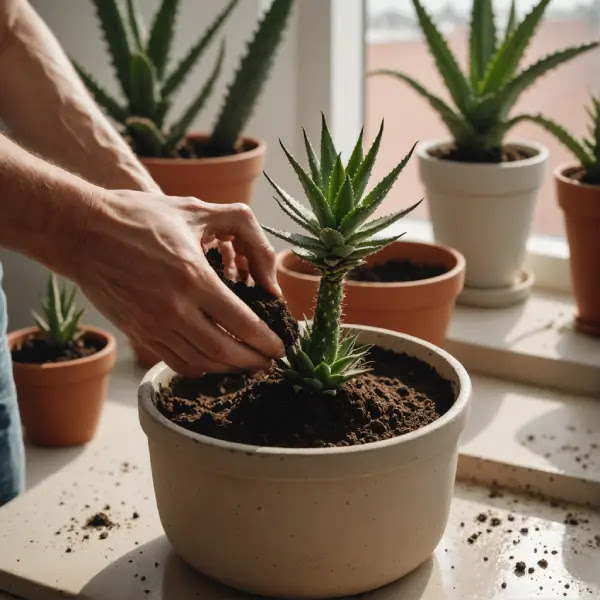Best Soil for Aloe Vera Plants: A Comprehensive Guide
Aloe Vera is one of the most popular houseplants, celebrated for its resilience, air-purifying qualities, and medicinal benefits. However, like any plant, it thrives when grown in the right conditions, especially with the appropriate soil.
Choosing the right soil ensures your Aloe Vera stays healthy, grows well, and avoids common issues like root rot. In this guide, we will delve into everything you need to know about the best soil for Aloe Vera plants, so you can provide optimal care for your beloved succulent.
1. Why Soil Matters for Aloe Vera Plants
Aloe Vera’s natural habitat is the arid, sandy regions of Africa. In these environments, the soil drains quickly and provides the roots with just the right amount of moisture. Mimicking these conditions at home is essential because:
A-Poor soil leads to overwatering and root rot.
B-Well-draining soil prevents water from pooling around the roots.
C-Proper soil aerates the roots, ensuring healthy growth.
For Aloe Vera to thrive, the soil should have the following properties:
Learn how to give your Aloe Vera plants the perfect soil for healthy growth and avoid common issues like root rot. Check out this comprehensive guide and video for expert tips on soil selection, DIY mixes, and care for thriving Aloe Vera plants—indoors and outdoors! Check this video.
Well-draining: Prevents water from sitting in the pot.
Aerated: Allows oxygen to reach the roots.
Slightly acidic to neutral pH: Ideal range is 6.0 to 7.0.
Low organic matter: Avoid overly rich soils that retain too much moisture.
While regular potting soil is readily available, it’s not ideal for Aloe Vera. Here's why:
A-Regular potting soil retains too much water.
B-It lacks the sandy or gritty texture Aloe Vera prefers.
Solution: Amend regular potting soil with sand, perlite, or pumice to improve drainage.
The best soil types for Aloe Vera include:
Cactus and succulent soil mix: Specifically formulated for desert plants.
Sandy or gritty soil: Mimics natural habitats.
Organic soil with amendments: Use cautiously to avoid excessive moisture retention.
Creating your own soil mix is cost-effective and ensures you’re providing the best conditions. Here’s a simple recipe:
Ingredients:
1 part sand or perlite
1 part potting soil
1 part compost or coconut coir (optional)
Steps:
A-Mix the ingredients thoroughly in a large container.
B-Test the drainage by watering a small amount.
C-Adjust the ratio if necessary for faster drainage.
Drainage is crucial to prevent root rot, one of the most common issues with Aloe Vera. Here’s how to ensure good drainage:
A-Use a pot with drainage holes.
B-Add a layer of gravel or small stones at the bottom of the pot.
C-Choose a soil mix that doesn’t compact over time.
If you prefer to buy soil, consider these options:
Miracle-Gro Cactus, Palm & Citrus Potting Mix: Affordable and widely available.
Hoffman Organic Cactus and Succulent Soil Mix: Great for organic gardening.
Superfly Bonsai Succulent & Cactus Soil Mix: A premium choice for Aloe Vera.
Indoor and outdoor Aloe Vera plants have slightly different needs:
Indoor plants: Use lighter soil mixes to reduce the risk of overwatering.
Outdoor plants: Choose coarser soils that can handle rain exposure.
Tip: Always monitor outdoor Aloe Vera plants during heavy rainfall.
Here are common issues and solutions:
Overwatering: Use sandy soil and water less frequently.
Compacted soil: Repot with a fresh mix to improve aeration.
Poor drainage: Add perlite or pumice to your soil mix.
Repotting helps refresh the soil and prevent issues. Follow these steps:
1.Remove the plant gently from its current pot.
2.Shake off excess soil from the roots.
3.Fill a new pot with the right soil mix.
4.Place the Aloe Vera and cover the roots lightly.
5.Water sparingly to settle the soil.
Q: Can Aloe Vera grow without soil?
Yes, in hydroponic setups, but soil provides better nutrients.
Q: What is the best container for Aloe Vera?
Terracotta pots are ideal as they allow soil to dry out faster.
Q: How often should you change the soil?
Repot every 1-2 years or when the soil becomes compacted.
Providing Aloe Vera with the right soil is key to keeping it healthy and thriving. Whether you create your own soil mix or buy a commercial product, ensuring proper drainage, aeration, and pH balance will set your plant up for success. Experiment with these tips, and enjoy the beauty and benefits of your Aloe Vera plant. If you have any questions or soil tips of your own, feel free to share them in the comments!















0 comments:
Post a Comment